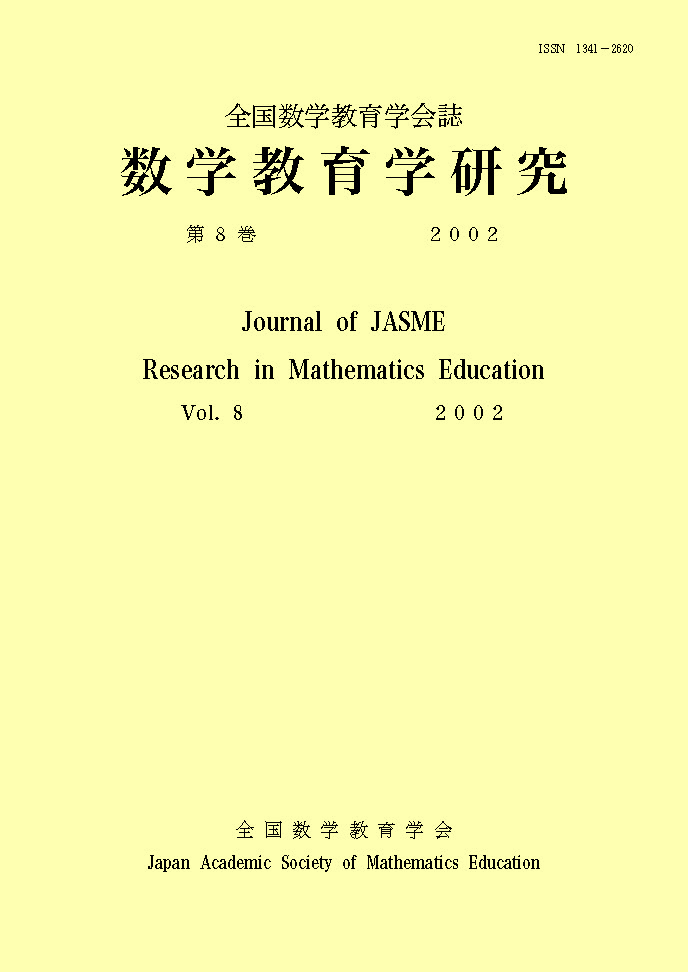8 巻
選択された号の論文の24件中1~24を表示しています
- |<
- <
- 1
- >
- >|
-
原稿種別: 本文
2002 年 8 巻 p. 1-9
発行日: 2002年
公開日: 2019/01/17
PDF形式でダウンロード (1097K) -
原稿種別: 本文
2002 年 8 巻 p. 11-18
発行日: 2002年
公開日: 2019/01/17
PDF形式でダウンロード (1054K) -
原稿種別: 本文
2002 年 8 巻 p. 19-29
発行日: 2002年
公開日: 2019/01/17
PDF形式でダウンロード (1324K) -
原稿種別: 本文
2002 年 8 巻 p. 31-38
発行日: 2002年
公開日: 2019/01/17
PDF形式でダウンロード (831K) -
原稿種別: 本文
2002 年 8 巻 p. 39-54
発行日: 2002年
公開日: 2019/01/17
PDF形式でダウンロード (1750K) -
原稿種別: 本文
2002 年 8 巻 p. 55-67
発行日: 2002年
公開日: 2019/01/17
PDF形式でダウンロード (1592K) -
原稿種別: 本文
2002 年 8 巻 p. 69-81
発行日: 2002年
公開日: 2019/01/17
PDF形式でダウンロード (1612K) -
原稿種別: 本文
2002 年 8 巻 p. 83-94
発行日: 2002年
公開日: 2019/01/17
PDF形式でダウンロード (1343K) -
原稿種別: 本文
2002 年 8 巻 p. 95-107
発行日: 2002年
公開日: 2019/01/17
PDF形式でダウンロード (1470K) -
原稿種別: 本文
2002 年 8 巻 p. 109-118
発行日: 2002年
公開日: 2019/01/17
PDF形式でダウンロード (1167K) -
原稿種別: 本文
2002 年 8 巻 p. 119-128
発行日: 2002年
公開日: 2019/01/17
PDF形式でダウンロード (1106K) -
原稿種別: 本文
2002 年 8 巻 p. 129-137
発行日: 2002年
公開日: 2019/01/17
PDF形式でダウンロード (983K) -
原稿種別: 本文
2002 年 8 巻 p. 139-151
発行日: 2002年
公開日: 2019/01/17
PDF形式でダウンロード (1617K) -
原稿種別: 本文
2002 年 8 巻 p. 153-166
発行日: 2002年
公開日: 2019/01/17
PDF形式でダウンロード (1426K) -
原稿種別: 本文
2002 年 8 巻 p. 167-176
発行日: 2002年
公開日: 2019/01/17
PDF形式でダウンロード (999K) -
原稿種別: 本文
2002 年 8 巻 p. 177-186
発行日: 2002年
公開日: 2019/01/17
PDF形式でダウンロード (1012K) -
原稿種別: 本文
2002 年 8 巻 p. 187-199
発行日: 2002年
公開日: 2019/01/17
PDF形式でダウンロード (1280K) -
原稿種別: 本文
2002 年 8 巻 p. 201-214
発行日: 2002年
公開日: 2019/01/17
PDF形式でダウンロード (1377K) -
原稿種別: 本文
2002 年 8 巻 p. 215-223
発行日: 2002年
公開日: 2019/01/17
PDF形式でダウンロード (1004K) -
原稿種別: 本文
2002 年 8 巻 p. 225-233
発行日: 2002年
公開日: 2019/01/17
PDF形式でダウンロード (1280K) -
原稿種別: 本文
2002 年 8 巻 p. 235-242
発行日: 2002年
公開日: 2019/01/17
PDF形式でダウンロード (854K) -
原稿種別: 本文
2002 年 8 巻 p. 243-255
発行日: 2002年
公開日: 2019/01/17
PDF形式でダウンロード (1443K) -
原稿種別: 本文
2002 年 8 巻 p. 257-269
発行日: 2002年
公開日: 2019/01/17
PDF形式でダウンロード (1174K) -
原稿種別: 本文
2002 年 8 巻 p. 271-277
発行日: 2002年
公開日: 2019/01/17
PDF形式でダウンロード (791K)
- |<
- <
- 1
- >
- >|
